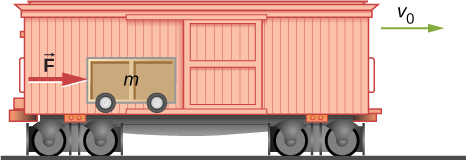| << Chapter < Page | Chapter >> Page > |
In two dimensions,
From this equation, you can see why [link] is the condition for the work to be an exact differential, in terms of the derivatives of the components of the force. In general, a partial derivative notation is used. If a function has many variables in it, the derivative is taken only of the variable the partial derivative specifies. The other variables are held constant. In three dimensions, you add another term for the z -component, and the result is that the force is the negative of the gradient of the potential energy. However, we won’t be looking at three-dimensional examples just yet.
where Its total energy at and it is not subject to any non-conservative forces. Find (a) the positions where its kinetic energy is zero and (b) the forces at those positions.
Check Your Understanding Find the forces on the particle in [link] when its kinetic energy is 1.0 J at
directed toward the origin
What is the physical meaning of a non-conservative force?
A force that takes energy away from the system that can’t be recovered if we were to reverse the action.
A bottle rocket is shot straight up in the air with a speed . If the air resistance is ignored, the bottle would go up to a height of approximately . However, the rocket goes up to only before returning to the ground. What happened? Explain, giving only a qualitative response.
An external force acts on a particle during a trip from one point to another and back to that same point. This particle is only effected by conservative forces. Does this particle’s kinetic energy and potential energy change as a result of this trip?
The change in kinetic energy is the net work. Since conservative forces are path independent, when you are back to the same point the kinetic and potential energies are exactly the same as the beginning. During the trip the total energy is conserved, but both the potential and kinetic energy change.
A force acts on a particle as it moves along the positive x -axis. (a) How much work does the force do on the particle as it moves from to (b) Picking a convenient reference point of the potential energy to be zero at find the potential energy for this force.
A force acts on a particle. (a) How much work does the force do on the particle as it moves from to (b) Picking a convenient reference point of the potential energy to be zero at find the potential energy for this force.
Find the force corresponding to the potential energy
The potential energy function for either one of the two atoms in a diatomic molecule is often approximated by where x is the distance between the atoms. (a) At what distance of seperation does the potential energy have a local minimum (not at (b) What is the force on an atom at this separation? (c) How does the force vary with the separation distance?
a. ; b. ; c.
A particle of mass moves under the influence of the force If its speed at is what is its speed at
A particle of mass moves under the influence of the force If its speed at is what is its speed at
A crate on rollers is being pushed without frictional loss of energy across the floor of a freight car (see the following figure). The car is moving to the right with a constant speed If the crate starts at rest relative to the freight car, then from the work-energy theorem, where d , the distance the crate moves, and v , the speed of the crate, are both measured relative to the freight car. (a) To an observer at rest beside the tracks, what distance is the crate pushed when it moves the distance d in the car? (b) What are the crate’s initial and final speeds and as measured by the observer beside the tracks? (c) Show that and, consequently, that work is equal to the change in kinetic energy in both reference systems.


Notification Switch
Would you like to follow the 'University physics volume 1' conversation and receive update notifications?